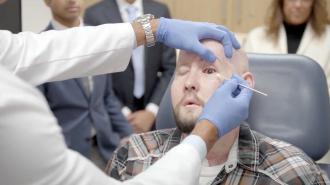Surgeons at NYU Langone have performed the world’s first whole eye transplant. The recipient can’t see out of his new eye, but it’s still healthy more than five months after the operation — putting doctors a major step closer to restoring vision with donor eyes in the future.
The patient: Aaron James, a 46-year-old military vet living in Arkansas, was working as a high-voltage lineman in 2021 when he came in contact with a live wire. The accident caused severe burns that led to the loss of his left eye, his nose, his mouth, half of his face, and his left arm from just above the elbow.
Doctors at NYU Langone became aware of Aaron’s case two months later. The hospital’s face transplant program is one of the best in the world, and after talking to Aaron, his family, and his doctors, they determined that he would be a good candidate for a partial face transplant.
They also thought it might be worthwhile to give Aaron a new eye along with his new face.
“The risk versus reward ratio of transplanting the eye was very low.”
Eduardo D. Rodriguez
They didn’t expect that Aaron would be able to see through the donor eye, but a whole eye transplant had never been done before, and if they could simply get Aaron’s new eye to survive, it might be a stepping stone to restoring vision through eye transplants in the future.
“Given Aaron needed a face transplant and will be taking immunosuppressive drugs regardless, the risk versus reward ratio of transplanting the eye was very low,” said lead surgeon Eduardo D. Rodriguez, who serves as director of NYU’s Face Transplant Program.
The eye transplant: After just three months on the organ transplant waiting list, Aaron was matched with a donor in May 2023.
During a 21-hour-long procedure, a team of more than 140 surgeons, nurses, and other healthcare workers at NYU Langone transplanted most of the donor’s face — including his nose, mouth, and parts of his skull and face bones — onto Aaron.
“You would never think he underwent such a procedure so recently.”
Eduardo D. Rodriguez
They also injected adult stem cells they had extracted from the donor’s bone marrow into what remained of Aaron’s left optic nerve — the nerve that transmits electrical signals from the eye to the brain — before attaching his new eye to it.
Their hope was that this would encourage nerve regeneration and increase the possibility of Aaron seeing through the donor eye.
The results: The NYU Langone team’s goal was for Aaron’s new eye to survive for at least 90 days. It’s now been more than five months since the eye transplant, and while Aaron can’t see through his new eye, it still looks healthy, with good blood flow and no signs of rejection.
His new face is looking great, too, according to Rodriguez: “Beyond the eye, the quality of Aaron’s results from the face transplant is special. You would never think he underwent such a procedure so recently.”
Looking ahead: Aaron was able to return to his home in Arkansas in September, and he’s now looking forward to Thanksgiving — this will be the first Turkey Day since his accident that he’ll be able to taste, smell, and eat solid food.
The NYU team is regularly testing Aaron’s new eye and considering ways to help restore vision in it in the future, such as through additional stem cell transplants, the administration of proteins called “growth factors,” or even a bionic eye.
“I don’t think anyone can claim that he will see, but by the same token, they can’t claim that he will not see,” Rodriguez told Reuters. “At this point, I think we’re pretty happy with the result that we were able to achieve with a very technically demanding operation.”
We’d love to hear from you! If you have a comment about this article or if you have a tip for a future Freethink story, please email us at [email protected].






